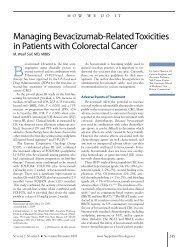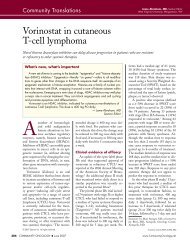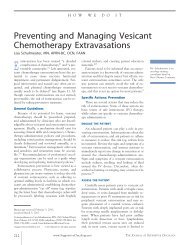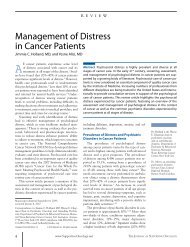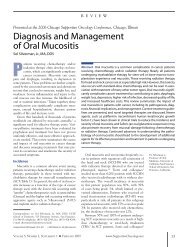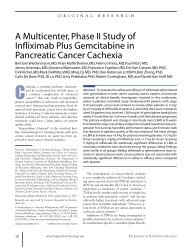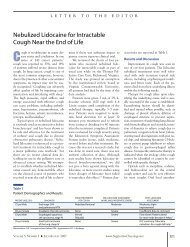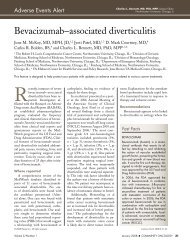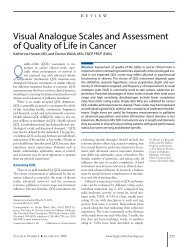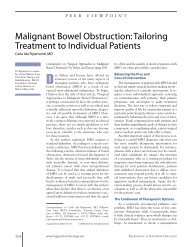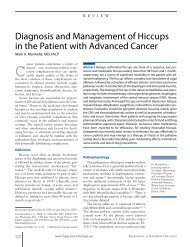Impact of Zoledronic Acid on Renal Function in Patients With Cancer ...
Impact of Zoledronic Acid on Renal Function in Patients With Cancer ...
Impact of Zoledronic Acid on Renal Function in Patients With Cancer ...
You also want an ePaper? Increase the reach of your titles
YUMPU automatically turns print PDFs into web optimized ePapers that Google loves.
McDermott, Kloth, Wang, et al<br />
Table 4<br />
Univariate Analysis for Predictors <str<strong>on</strong>g>of</str<strong>on</strong>g> Deteriorati<strong>on</strong> <strong>in</strong> <strong>Renal</strong> Functi<strong>on</strong><br />
FACTOR VARIABLE PATIENTS (n) EVENTS (n) P VALUE a ODDS RATIO [95% CI]<br />
Gender Male 222 22 0.7229 1.12 [0.59, 2.12]<br />
Female 224 20<br />
Age a 446 42 0.0160 1.04 [1.01, 1.07]<br />
Basel<strong>in</strong>e creat<strong>in</strong><strong>in</strong>e level < 1.4 mg/dL 407 34 0.0167 0.35 [0.15, 0.83]<br />
≥ 1.4 mg/dL 39 8<br />
Doses a 446 42 0.0455 1.05 [1.00, 1.09]<br />
Diabetes No 388 33 0.0933 0.51 [0.23, 1.12]<br />
Yes 58 9<br />
Hypertensi<strong>on</strong> No 277 19 0.020 0.47 [0.25, 0.89]<br />
Yes 169 23<br />
NSAID, current use No 338 24 0.0040 0.38 [0.20, 0.74]<br />
Yes 108 18<br />
Diuretic, current use No 369 30 0.0454 0.48 [0.23, 0.98]<br />
Yes 77 12<br />
Aspir<strong>in</strong>, current use No 386 36 0.8680 0.93 [0.37, 2.30]<br />
Yes 60 6<br />
Cisplat<strong>in</strong>, current or prior use No 431 39 0.1670 0.40 [0.11, 1.47]<br />
Yes 15 3<br />
Thalidomide, current or prior use No 433 38 0.0142 0.22 [0.06, 0.74]<br />
Yes 13 4<br />
<strong>Cancer</strong> diagnosis Myeloma 35 5 0.0276 1.88 [0.68, 5.17]<br />
(myeloma vs other)<br />
<strong>Renal</strong> 19 5 4.02 [1.36, 11.87]<br />
(renal vs other)<br />
Other 392 32 0.47 [0.12, 1.88]<br />
(myeloma vs renal)<br />
Bold numbers represent statistical significance.<br />
a<br />
Treated as a c<strong>on</strong>t<strong>in</strong>uous variable. Abbreviati<strong>on</strong>s: CI = c<strong>on</strong>fidence <strong>in</strong>terval; NSAID = n<strong>on</strong>steroidal anti-<strong>in</strong>flammatory drug<br />
doses received, a diagnosis <str<strong>on</strong>g>of</str<strong>on</strong>g> renal cell carc<strong>in</strong>oma or myeloma,<br />
hypertensi<strong>on</strong>, c<strong>on</strong>comitant therapy with NSAIDs or diuretics,<br />
and current or prior therapy with thalidomide.<br />
MULTIVARIATE ANALYSIS<br />
Stepwise variable selecti<strong>on</strong> <strong>in</strong> the c<strong>on</strong>text <str<strong>on</strong>g>of</str<strong>on</strong>g> b<strong>in</strong>ary logistic<br />
regressi<strong>on</strong> identified the follow<strong>in</strong>g subset <str<strong>on</strong>g>of</str<strong>on</strong>g> factors significantly<br />
and <strong>in</strong>dependently associated with renal deteriorati<strong>on</strong>: patient<br />
age, a diagnosis <str<strong>on</strong>g>of</str<strong>on</strong>g> myeloma or renal cell cancer, the number<br />
<str<strong>on</strong>g>of</str<strong>on</strong>g> doses received, c<strong>on</strong>comitant therapy with an NSAID, and<br />
current or prior therapy with cisplat<strong>in</strong> (Table 5).<br />
PREDICTIVE MODEL<br />
The subset <str<strong>on</strong>g>of</str<strong>on</strong>g> factors found to be significant <strong>on</strong> multivariable<br />
analysis was used to c<strong>on</strong>struct a logistic regressi<strong>on</strong> model<br />
to predict patient risk <str<strong>on</strong>g>of</str<strong>on</strong>g> develop<strong>in</strong>g renal deteriorati<strong>on</strong> while<br />
<strong>on</strong> therapy with zoledr<strong>on</strong>ic acid. Accord<strong>in</strong>g to this model, a<br />
patient is classified as hav<strong>in</strong>g experienced renal deteriorati<strong>on</strong><br />
<strong>on</strong>ly if his or her predicted risk (ie, estimated c<strong>on</strong>diti<strong>on</strong>al<br />
probability) is greater than a selected threshold. In particular,<br />
if the threshold is set at 10%, as is c<strong>on</strong>sistent with the available<br />
literature <strong>on</strong> the <strong>in</strong>cidence <str<strong>on</strong>g>of</str<strong>on</strong>g> renal deteriorati<strong>on</strong> with the<br />
use <str<strong>on</strong>g>of</str<strong>on</strong>g> zoledr<strong>on</strong>ic acid, the logistic regressi<strong>on</strong> predicti<strong>on</strong> model<br />
to identify patients with renal deteriorati<strong>on</strong> was observed to<br />
have a sensitivity <str<strong>on</strong>g>of</str<strong>on</strong>g> 64.3% and a specificity <str<strong>on</strong>g>of</str<strong>on</strong>g> 69.8%. Figure<br />
1 shows the ROC curve associated with the multivariable logistic<br />
regressi<strong>on</strong> model. The area under the ROC curve was<br />
estimated to be 0.75.<br />
CLINICAL SIGNIFICANCE<br />
The patient care pathway subsequent to the development <str<strong>on</strong>g>of</str<strong>on</strong>g><br />
renal deteriorati<strong>on</strong> is outl<strong>in</strong>ed <strong>in</strong> Figure 2. In 19 cases, zoledr<strong>on</strong>ic<br />
acid therapy was c<strong>on</strong>t<strong>in</strong>ued. Two <str<strong>on</strong>g>of</str<strong>on</strong>g> these patients had developed<br />
obstructive uropathy due to progressive disease <strong>in</strong> the pelvis<br />
(<strong>on</strong>e with prostate cancer, <strong>on</strong>e with renal cancer). Follow<strong>in</strong>g<br />
urologic <strong>in</strong>terventi<strong>on</strong>, serum creat<strong>in</strong><strong>in</strong>e levels normalized, and<br />
zoledr<strong>on</strong>ic acid therapy was resumed. In 17 cases, zoledr<strong>on</strong>ic<br />
acid was c<strong>on</strong>t<strong>in</strong>ued as the treat<strong>in</strong>g physician thought that the<br />
rise <strong>in</strong> serum creat<strong>in</strong><strong>in</strong>e levels was not cl<strong>in</strong>ically significant. In<br />
n<strong>in</strong>e <str<strong>on</strong>g>of</str<strong>on</strong>g> these cases, serum creat<strong>in</strong><strong>in</strong>e levels subsequently fell<br />
with c<strong>on</strong>t<strong>in</strong>ued therapy so they no l<strong>on</strong>ger fulfilled the def<strong>in</strong>iti<strong>on</strong><br />
<str<strong>on</strong>g>of</str<strong>on</strong>g> renal deteriorati<strong>on</strong>. In seven cases, serum creat<strong>in</strong><strong>in</strong>e levels<br />
rema<strong>in</strong>ed stable with c<strong>on</strong>t<strong>in</strong>ued therapy, fulfill<strong>in</strong>g the criteria<br />
for renal deteriorati<strong>on</strong>, and <strong>in</strong> <strong>on</strong>e case, although further zoledr<strong>on</strong>ic<br />
acid was planned, it had not yet been adm<strong>in</strong>istered by<br />
study end.<br />
In 23 cases, no further zoledr<strong>on</strong>ic acid therapy was adm<strong>in</strong>istered<br />
after the observati<strong>on</strong> <str<strong>on</strong>g>of</str<strong>on</strong>g> renal deteriorati<strong>on</strong>. Of this total,<br />
VOLUME 4, NUMBER 10 ■ NOVEMBER/DECEMBER 2006<br />
www.SupportiveOncology.net<br />
527



